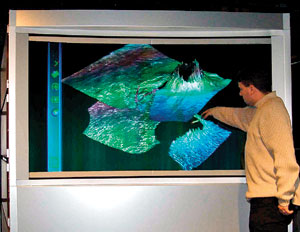What's new in exploration
Truly Passive 3D. On rare occasion, a technology catches my eye that is sufficiently different that it should be brought to everybody's attention. Such is the case with QinetiQ's new passive 3D. By truly passive 3D, I mean glasses-free, and in a well-lit room to boot. Most so-called passive 3D systems still require glasses, it's just that the left and right sides do not flip, or oscillate: they are polarized and fixed. Active systems require glasses that are a bit more bulky, have batteries or wires, and actively switch left and right frame polarity. Why is this important? Well, it's difficult for someone such as me to say with certainty, after only a few dozen demo experiences: I do not work in 3D on a daily basis. But it seems that the combination of glasses and dimly lit rooms are two attributes of current and past systems that must be done away with for the following reasons. First, the bright room allows collaborators to bring their notes and pencil and paper, and see what they are doing without having to leave the room or turn up the lights. I'm sure that this inescapable advantage has not been missed. The other reason is cultural. If you live in a culture, such as in the West, where one automatically puts a high value on eye contact, take a minute to think about what it's like talking to someone with that bug-eyed look. Is he believable? To see what the other person is saying, whether they have doubts, pleading, desperation, to see if there's a bit of a smile in their eyes, and so on, we look for facial clues. We do it instinctively. It just can't be done in the bug-eyed domain. The demonstration I attended was held at Fairfield's main offices in Houston. The seismic data acquisition firm was showing a new attribute analysis routine called SPICE (SPectral Imaging of Correlative Events). Oversimplified, it uses the continuous wavelet transform and singularity analysis to investigate the time-frequency details of the seismic trace. SPICE provides a layered, subsurface view, rich in structural and stratigraphic detail. QinetiQ says that the display system has more than 25 times the information content and is 10 times brighter than conventional stereo visualization images, while an OpenGL interface allows seamless integration with existing interpretation and visualization applications. I can believe the company when it says that there are no environmental effects from extended use, such as headaches or queasiness. The 3D effect was remarkable. There wasn't a screen in front of a screen, as I expected. There did seem to be some sort of a vertical, lenticular effect, visible if you moved around, which, if there were a series of vertical lenses, would make sense as to how it works. But I was informed that was not the case. So how it works, I still do not know.
The screen I saw was set at +/- 4 ft, that is, 4 ft into and 4 ft in front of the screen. This distance can be adjusted. When someone points to something “inside” the image, all viewers within the 70° field of view see his finger pointing to the same object. The screen I saw was 6 ft wide, but versions will be available up to 20 ft. The 2D part is high resolution as well: text was nice and crisp amidst 3D geobodies. The interesting part of this was that it was only a pre-production prototype. Viewing angles, resolution, and other improvements are in progress. Then the scary part hit me. If any viewing surface can be converted into natural, passive 3D, does this mean that, someday, I can look forward to seeing 3D junk mail? Methane outgassing. We all have read about those wacky atmospheric scientists who wanted to know how much methane in the atmosphere came from ruminants, that is, cattle, goats, sheep, buffalo and the like. It made wonderful derisive news for politicians, comedians, pundits, late-night talk-show hosts, editors and other evil-doers, bent on tickling the fancy of an all-too-easy-to-fool public. “Governments spend millions to study cow farts,” read the headlines. At times, I thought I was the only person on the planet interested in the outcome. In case you've forgotten the results (!), the best guess as to methane's role in global warming is 15 – 18% of the effect. Methane is about 21 times as potent a greenhouse gas as is carbon dioxide. Ruminant livestock produce 80 million tons of methane annually, which is about 22% of global methane emissions from human endeavors. So imagine my surprise upon learning that methane from geologic sources is not as well known as from cows. Researchers Giuseppe Etiope and Alexei Milkov have quantified one of the missing methane sources – mud volcanoes. Worldwide, there are more than 900 mud volcanoes in 26 countries, with 300 more on shallow ocean shelves and many others uncounted. These volcanoes can be less than 3-ft to more than 2,000-ft high. As reported in the June issue of Geology, the two scientists measured the methane output of a mud volcano in eastern Azerbaijan. It turns out that these mud volcanoes produce up to 6 to 10 million tonnes of methane per year into the atmosphere. Worldwide, they emit up to 25% of the annual geologic methane input to the atmosphere. Why geologic sources of methane have not been included in the foremost climate change models? It's “basically a lack of multidisciplinary climate studies,” says Etiope. Their contribution could have enormous implications for climate change models. Etiope is a geologist at the National Institute of Geophysics and Volcanology in Rome. Milkov is a geologist with BP in Houston.
|
|||||||||||





